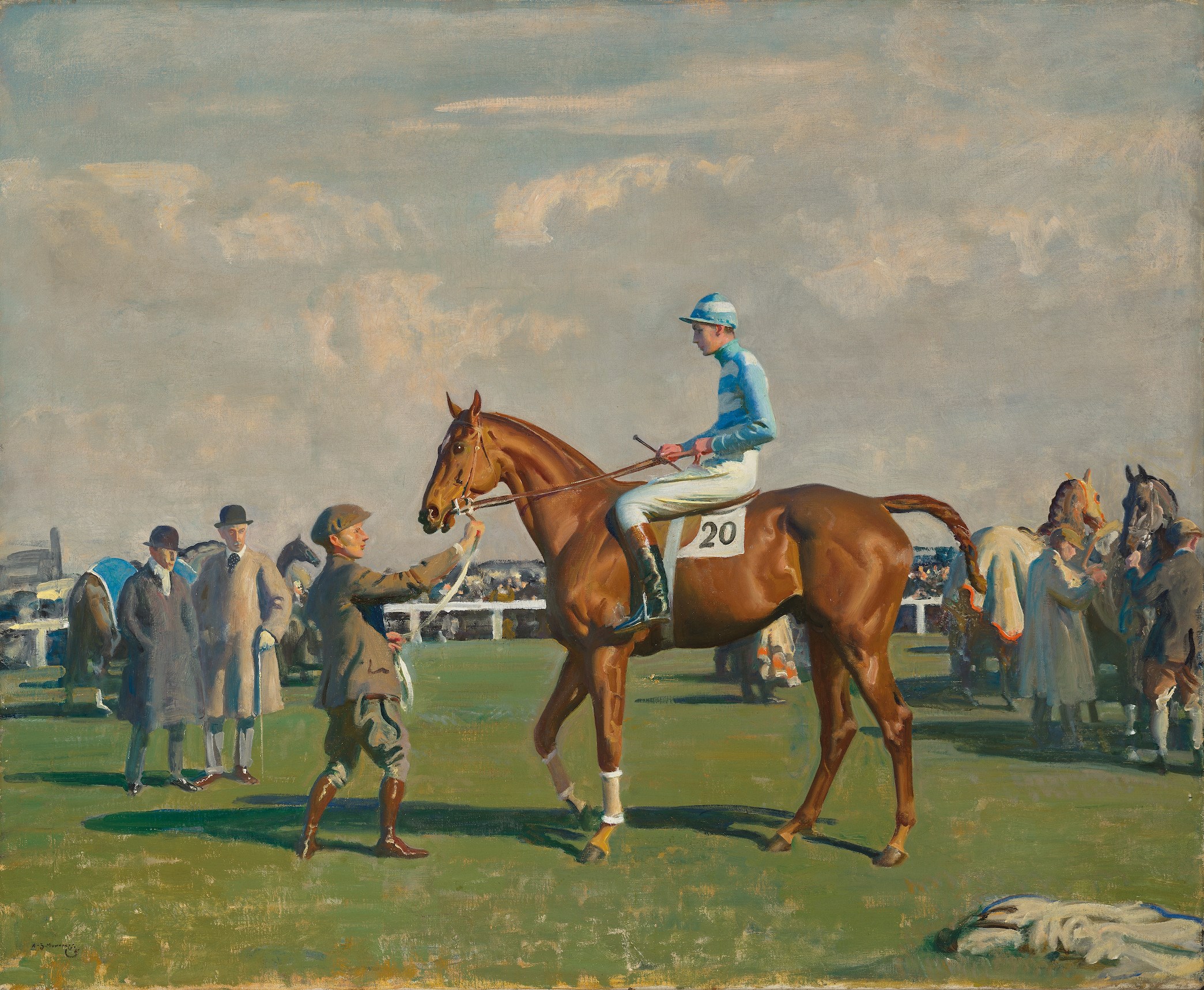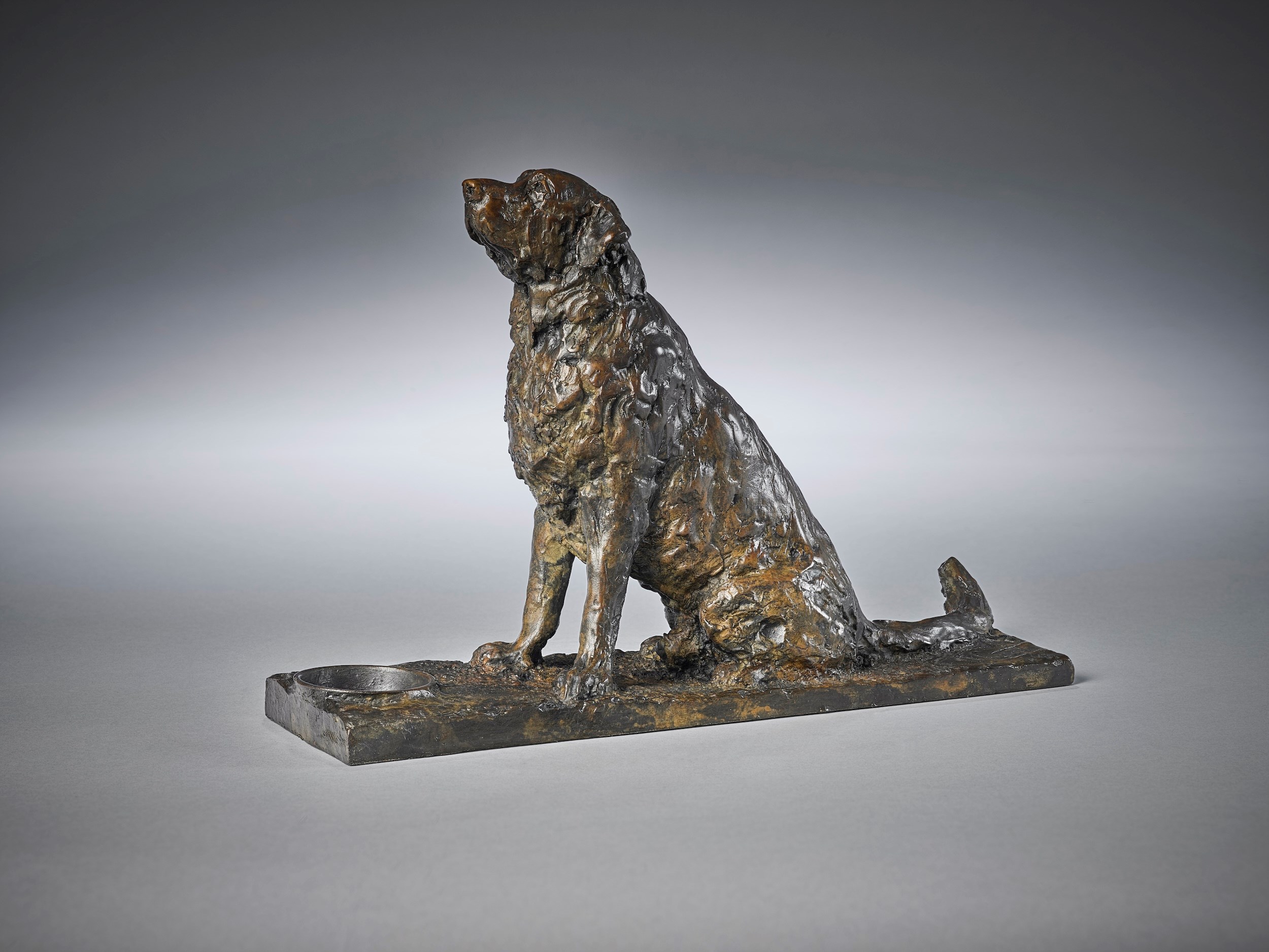Animal Portraiture
11 April 2024
Share
Have you ever heard the theory that pets look like their owners?
By Lucy Lethbridge
Lucy Lethbridge is a journalist and writer. She has written several history books, including, most recently, Tourists: How the British Went Abroad to Find Themselves.
A portrait of a pet dog or cat is often simply an expression of their human’s emotion: the love of an owner for an animal companion. It’s difficult not to see one of Gwen John’s self-contained cats without seeing there a reflection of the artist’s own austere and self-sufficient aesthetic vision. In an eighteenth-century painting by George Stubbs, horses and dogs bestride the landscape like their aristocratic owners, grand tourists surveying a world of which they are the heirs and overlords. The pre-eminent early twentieth-century painter of horses, Alfred Munnings, shows the world not only of the racing plutocrats of his time but the poignant dignity of horses in the man-made hellscapes of the First World War. A painting by Munnings, full of excitement and energy, recently displayed by the Rountree Tryon Gallery was commissioned by Baron Mildmay to depict his son on the horse Davy Jones, just before the 1936 Grand National. The great Victorian animal artist Edwin Landseer often placed his animals in theatrical tableaux: a large white poodle, for example, playing the judge in ‘Trial by Jury’ (1840). Even Nipper, the terrier made famous in Francis Barraud’s 1898 ‘His Master’s Voice’ was intended to advertise the hours of companionable family pleasure to be found in listening to a phonograph.

Sir Alfred James Munnings, P.R.A., R.W.S. 'Davy Jones with the Hon. Anthony Mildmay up'
Image courtesy of Rountree Tryon Galleries
Even though that kind of anthropomorphism is less fashionable now, animal portraits speak vividly to us still. And a whole new generation of animal artists has emerged to capture horses, dogs, cats and even farm animals for their owners. Michael J Austin, whose wonderful depiction of a horse’s head, Inception 2023, is on show with the Jonathan Cooper gallery at the Treasure House art fair this year, is a fan of Landseer. But he sees Landseer’s dogs as belonging to a particular context; they belong to a ‘wider scene.’ And Martin is less keen than the Victorian artist on ‘fluffy’ animals: he prefers, for example, whippets or beasts in which you can ‘see the musculature.’ His own paintings are vivid examples of painstakingly close observation of the bones working beneath the skin. His horse’s head bends forward in profile with a combination of submission and nobility. It’s a gesture Martin finds particularly powerful and he observes that it is a feature of un-bridled horses, noting that the steeds found in, for example, ancient Greek reliefs, have reins pulled tight in battle and heads lifted.
_T638484384466118841.jpg) Sir Edwin Landseer, R.A., R.I. 'The rounded English pig and the scrawny French pig pen and brown ink'
Sir Edwin Landseer, R.A., R.I. 'The rounded English pig and the scrawny French pig pen and brown ink'
Image courtesy of Rountree Tryon Galleries
Originally Martin painted primarily human portraits but since moving to Devon several years ago became interested in cattle, particularly bulls with their rippling muscles and bulk. In bulls too, he tells me, it is the downward head that speaks most strongly of the nature of the entire animal, even when they have lost their horns. They are in battle mode, ‘ready to charge, forehead to forehead.’
Sculptor Mark Coreth, whose depiction of a guide dog (that most moving of animal/human co-dependencies) will be shown by the Sladmore Gallery at Treasure House in maquette, is similarly eloquent on the importance of capturing the elusive ‘essence’ of his animal subjects. Because an animal model of course won’t stay still to order, the artist has to use on other senses. Correth works as far as possible ‘face to face’ and though he takes photographs, he says, he doesn’t end up using them much: the process of capturing the form of the animal is more about memory and feeling. ‘One’s eyes are the lenses and one’s memories are on the memory stick,’ he says. ‘It comes from within, an internal recording.’
_T638485200449140049.jpg) Mark Coreth in his studio, Wiltshire, 2021
Mark Coreth in his studio, Wiltshire, 2021
Image courtesy of Sladmore Gallery
Coreth has sculpted animals in the wild and also animals for commission. His most famous is probably his 2016 bronze of Frankel the racehorse, unveiled by the Queen at Newmarket. ‘There is,’ he says, ‘a very deep bond between an artist and his animal. You’ve got to become the animal, to understand it.’ Coreth, like Martin, is fascinated by the brute strength of bulls. He created a bronze of Rodmead Prague, a splendid, prize-winning ‘solid-A’ bull from Wiltshire, beloved of his proud farmer owner.
Coreth tells of a gorilla model he once studied in London Zoo. The two of them, artist and ‘beastie’ stood eye to eye for hours in mutual communion. ‘It’s portraiture in its raw form,’ he says. Making a portrait of an animal, revealing something truthful about animal nature, is a pilgrimage of empathy.
 Guide Dog ‘Grady’, maquette, 2024 by Mark Coreth (British, b.1958), Bronze, Height: 38” (97cm)
Guide Dog ‘Grady’, maquette, 2024 by Mark Coreth (British, b.1958), Bronze, Height: 38” (97cm)
Image courtesy of Sladmore Gallery
By Lucy Lethbridge
Lucy Lethbridge is a journalist and writer. She has written several history books, including, most recently, Tourists: How the British Went Abroad to Find Themselves.
A portrait of a pet dog or cat is often simply an expression of their human’s emotion: the love of an owner for an animal companion. It’s difficult not to see one of Gwen John’s self-contained cats without seeing there a reflection of the artist’s own austere and self-sufficient aesthetic vision. In an eighteenth-century painting by George Stubbs, horses and dogs bestride the landscape like their aristocratic owners, grand tourists surveying a world of which they are the heirs and overlords. The pre-eminent early twentieth-century painter of horses, Alfred Munnings, shows the world not only of the racing plutocrats of his time but the poignant dignity of horses in the man-made hellscapes of the First World War. A painting by Munnings, full of excitement and energy, recently displayed by the Rountree Tryon Gallery was commissioned by Baron Mildmay to depict his son on the horse Davy Jones, just before the 1936 Grand National. The great Victorian animal artist Edwin Landseer often placed his animals in theatrical tableaux: a large white poodle, for example, playing the judge in ‘Trial by Jury’ (1840). Even Nipper, the terrier made famous in Francis Barraud’s 1898 ‘His Master’s Voice’ was intended to advertise the hours of companionable family pleasure to be found in listening to a phonograph.

Sir Alfred James Munnings, P.R.A., R.W.S. 'Davy Jones with the Hon. Anthony Mildmay up'
Image courtesy of Rountree Tryon Galleries
Even though that kind of anthropomorphism is less fashionable now, animal portraits speak vividly to us still. And a whole new generation of animal artists has emerged to capture horses, dogs, cats and even farm animals for their owners. Michael J Austin, whose wonderful depiction of a horse’s head, Inception 2023, is on show with the Jonathan Cooper gallery at the Treasure House art fair this year, is a fan of Landseer. But he sees Landseer’s dogs as belonging to a particular context; they belong to a ‘wider scene.’ And Martin is less keen than the Victorian artist on ‘fluffy’ animals: he prefers, for example, whippets or beasts in which you can ‘see the musculature.’ His own paintings are vivid examples of painstakingly close observation of the bones working beneath the skin. His horse’s head bends forward in profile with a combination of submission and nobility. It’s a gesture Martin finds particularly powerful and he observes that it is a feature of un-bridled horses, noting that the steeds found in, for example, ancient Greek reliefs, have reins pulled tight in battle and heads lifted.
_T638484384466118841.jpg) Sir Edwin Landseer, R.A., R.I. 'The rounded English pig and the scrawny French pig pen and brown ink'
Sir Edwin Landseer, R.A., R.I. 'The rounded English pig and the scrawny French pig pen and brown ink'Image courtesy of Rountree Tryon Galleries
Originally Martin painted primarily human portraits but since moving to Devon several years ago became interested in cattle, particularly bulls with their rippling muscles and bulk. In bulls too, he tells me, it is the downward head that speaks most strongly of the nature of the entire animal, even when they have lost their horns. They are in battle mode, ‘ready to charge, forehead to forehead.’
Sculptor Mark Coreth, whose depiction of a guide dog (that most moving of animal/human co-dependencies) will be shown by the Sladmore Gallery at Treasure House in maquette, is similarly eloquent on the importance of capturing the elusive ‘essence’ of his animal subjects. Because an animal model of course won’t stay still to order, the artist has to use on other senses. Correth works as far as possible ‘face to face’ and though he takes photographs, he says, he doesn’t end up using them much: the process of capturing the form of the animal is more about memory and feeling. ‘One’s eyes are the lenses and one’s memories are on the memory stick,’ he says. ‘It comes from within, an internal recording.’
_T638485200449140049.jpg) Mark Coreth in his studio, Wiltshire, 2021
Mark Coreth in his studio, Wiltshire, 2021Image courtesy of Sladmore Gallery
Coreth has sculpted animals in the wild and also animals for commission. His most famous is probably his 2016 bronze of Frankel the racehorse, unveiled by the Queen at Newmarket. ‘There is,’ he says, ‘a very deep bond between an artist and his animal. You’ve got to become the animal, to understand it.’ Coreth, like Martin, is fascinated by the brute strength of bulls. He created a bronze of Rodmead Prague, a splendid, prize-winning ‘solid-A’ bull from Wiltshire, beloved of his proud farmer owner.
Coreth tells of a gorilla model he once studied in London Zoo. The two of them, artist and ‘beastie’ stood eye to eye for hours in mutual communion. ‘It’s portraiture in its raw form,’ he says. Making a portrait of an animal, revealing something truthful about animal nature, is a pilgrimage of empathy.
 Guide Dog ‘Grady’, maquette, 2024 by Mark Coreth (British, b.1958), Bronze, Height: 38” (97cm)
Guide Dog ‘Grady’, maquette, 2024 by Mark Coreth (British, b.1958), Bronze, Height: 38” (97cm)Image courtesy of Sladmore Gallery

